A Comprehensive Review: Governance in For-Profit and Non-Profit Firms
VerifiedAdded on 2023/04/21
|10
|2156
|72
Report
AI Summary
This report provides a comparative analysis of governance in for-profit and non-profit organizations, reviewing two articles on the subject. The first article examines the governance of non-profit firms, highlighting the roles of managers, workers, donors, and customers, and the influence of donors on organizational policy. It recommends participative decision-making and negotiation with donors. The second article discusses 'Governance for Good,' focusing on guidelines for board members of Australian charities and not-for-profit organizations, emphasizing accountability, strategy, resourcing, and monitoring, as well as compliance with ACNC governance standards. The report concludes that good governance is crucial for both for-profit and non-profit organizations, requiring adherence to established rules and regulations.

Running head: GOVERNANCE IN ORGANIZATION
GOVERNANCE IN ORGANIZATION
Name of the Student:
Name of the University:
Author Note:
GOVERNANCE IN ORGANIZATION
Name of the Student:
Name of the University:
Author Note:
Paraphrase This Document
Need a fresh take? Get an instant paraphrase of this document with our AI Paraphraser
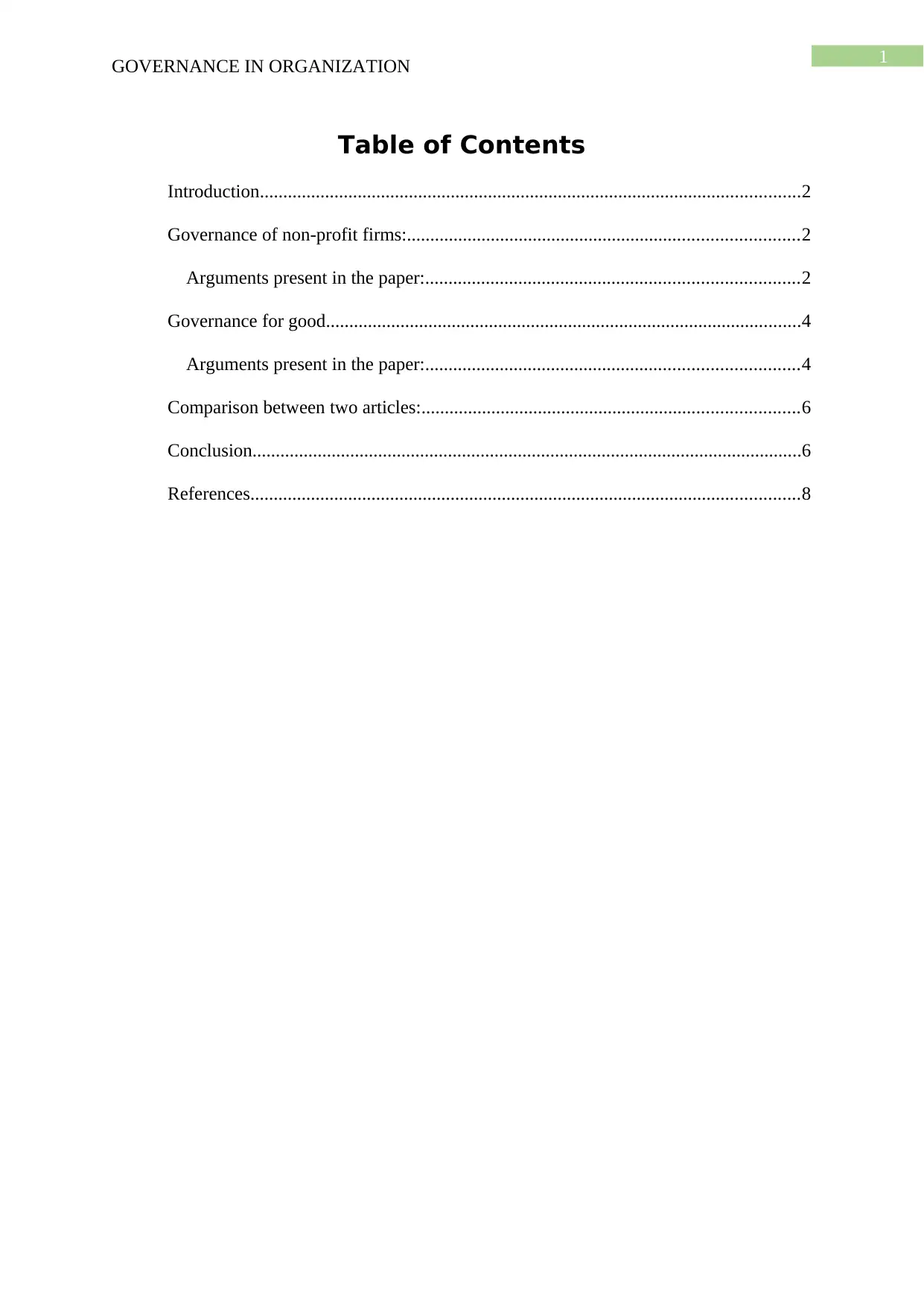
1
GOVERNANCE IN ORGANIZATION
Table of Contents
Introduction....................................................................................................................2
Governance of non-profit firms:....................................................................................2
Arguments present in the paper:................................................................................2
Governance for good......................................................................................................4
Arguments present in the paper:................................................................................4
Comparison between two articles:.................................................................................6
Conclusion......................................................................................................................6
References......................................................................................................................8
GOVERNANCE IN ORGANIZATION
Table of Contents
Introduction....................................................................................................................2
Governance of non-profit firms:....................................................................................2
Arguments present in the paper:................................................................................2
Governance for good......................................................................................................4
Arguments present in the paper:................................................................................4
Comparison between two articles:.................................................................................6
Conclusion......................................................................................................................6
References......................................................................................................................8
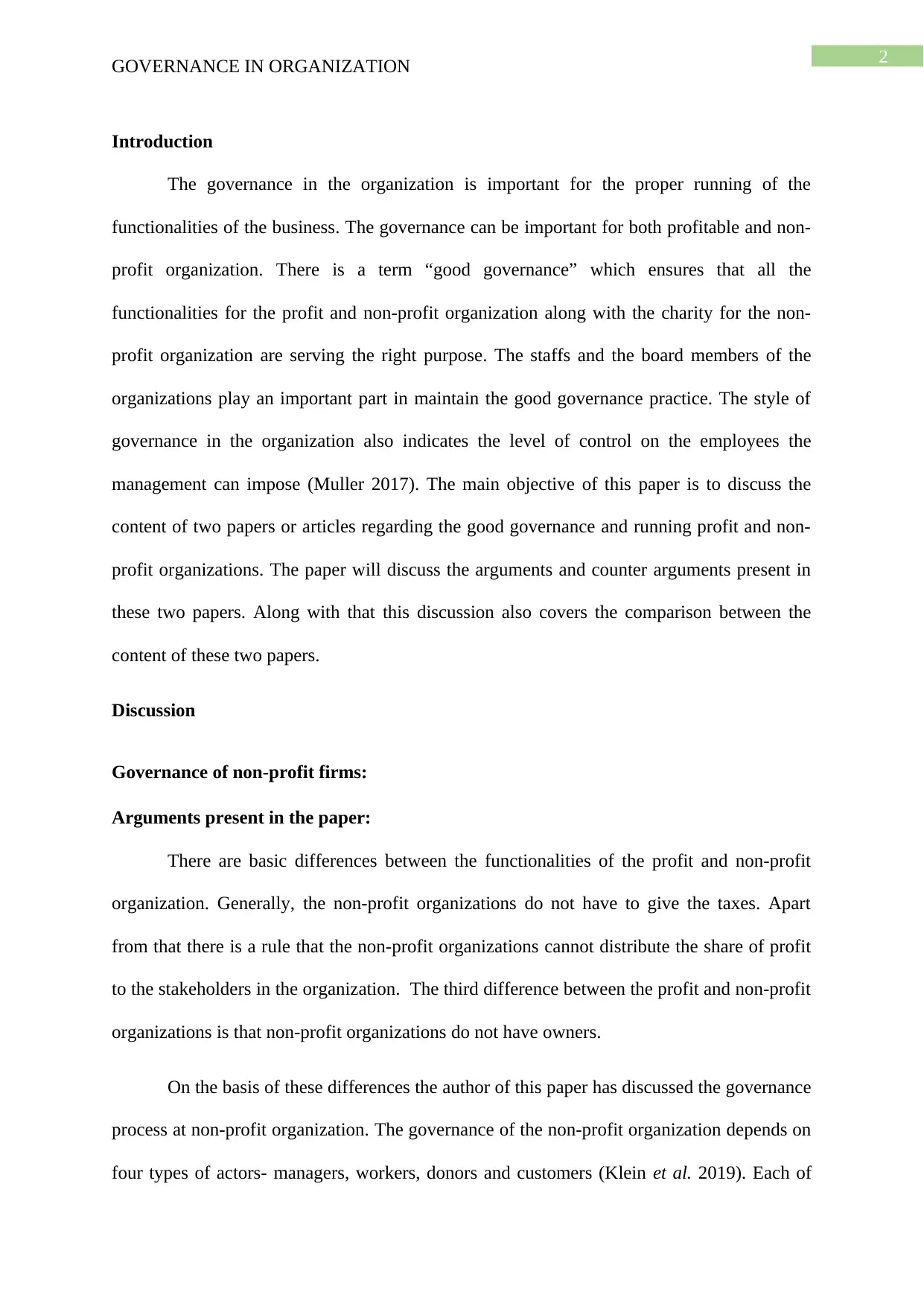
2
GOVERNANCE IN ORGANIZATION
Introduction
The governance in the organization is important for the proper running of the
functionalities of the business. The governance can be important for both profitable and non-
profit organization. There is a term “good governance” which ensures that all the
functionalities for the profit and non-profit organization along with the charity for the non-
profit organization are serving the right purpose. The staffs and the board members of the
organizations play an important part in maintain the good governance practice. The style of
governance in the organization also indicates the level of control on the employees the
management can impose (Muller 2017). The main objective of this paper is to discuss the
content of two papers or articles regarding the good governance and running profit and non-
profit organizations. The paper will discuss the arguments and counter arguments present in
these two papers. Along with that this discussion also covers the comparison between the
content of these two papers.
Discussion
Governance of non-profit firms:
Arguments present in the paper:
There are basic differences between the functionalities of the profit and non-profit
organization. Generally, the non-profit organizations do not have to give the taxes. Apart
from that there is a rule that the non-profit organizations cannot distribute the share of profit
to the stakeholders in the organization. The third difference between the profit and non-profit
organizations is that non-profit organizations do not have owners.
On the basis of these differences the author of this paper has discussed the governance
process at non-profit organization. The governance of the non-profit organization depends on
four types of actors- managers, workers, donors and customers (Klein et al. 2019). Each of
GOVERNANCE IN ORGANIZATION
Introduction
The governance in the organization is important for the proper running of the
functionalities of the business. The governance can be important for both profitable and non-
profit organization. There is a term “good governance” which ensures that all the
functionalities for the profit and non-profit organization along with the charity for the non-
profit organization are serving the right purpose. The staffs and the board members of the
organizations play an important part in maintain the good governance practice. The style of
governance in the organization also indicates the level of control on the employees the
management can impose (Muller 2017). The main objective of this paper is to discuss the
content of two papers or articles regarding the good governance and running profit and non-
profit organizations. The paper will discuss the arguments and counter arguments present in
these two papers. Along with that this discussion also covers the comparison between the
content of these two papers.
Discussion
Governance of non-profit firms:
Arguments present in the paper:
There are basic differences between the functionalities of the profit and non-profit
organization. Generally, the non-profit organizations do not have to give the taxes. Apart
from that there is a rule that the non-profit organizations cannot distribute the share of profit
to the stakeholders in the organization. The third difference between the profit and non-profit
organizations is that non-profit organizations do not have owners.
On the basis of these differences the author of this paper has discussed the governance
process at non-profit organization. The governance of the non-profit organization depends on
four types of actors- managers, workers, donors and customers (Klein et al. 2019). Each of
⊘ This is a preview!⊘
Do you want full access?
Subscribe today to unlock all pages.

Trusted by 1+ million students worldwide
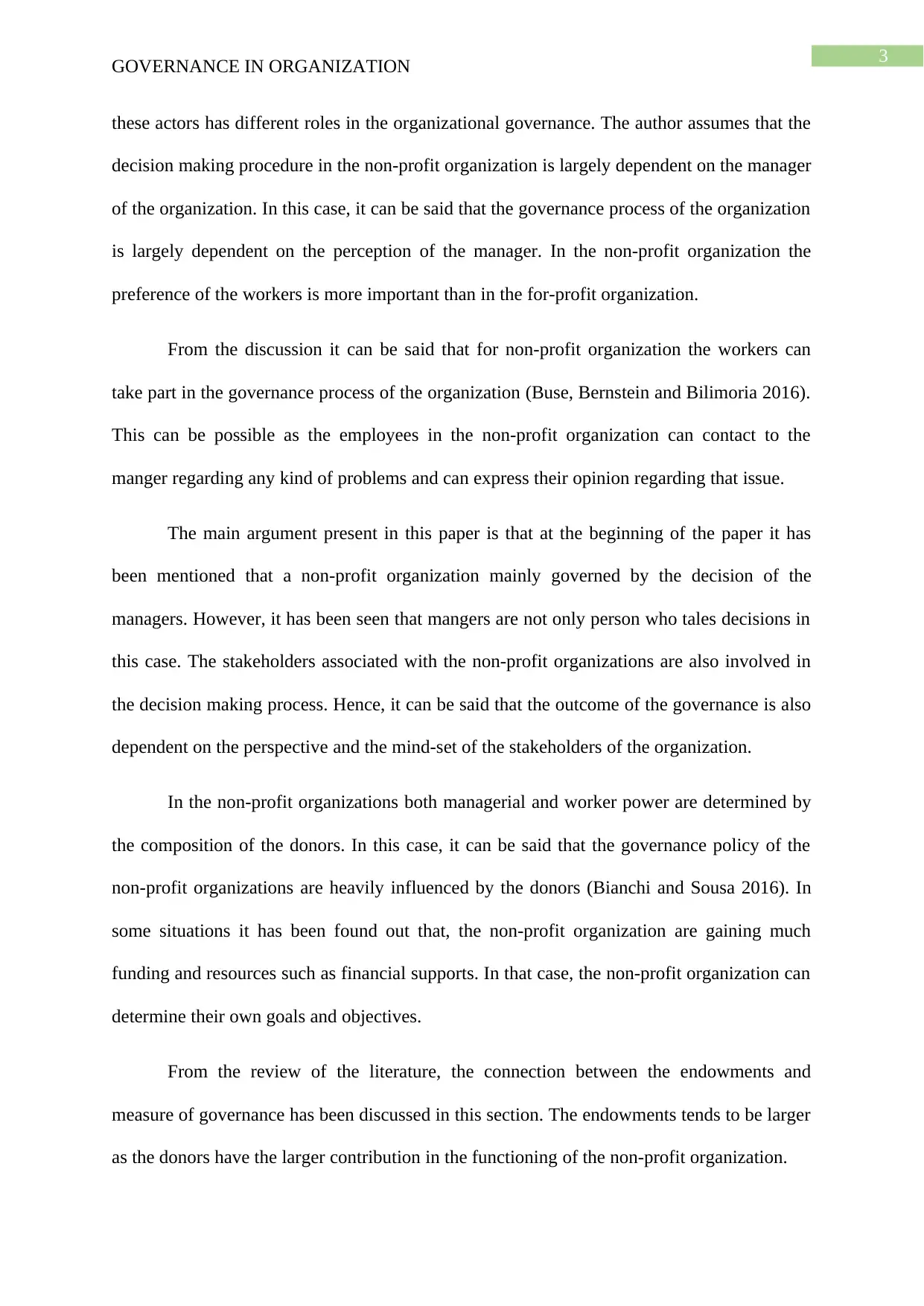
3
GOVERNANCE IN ORGANIZATION
these actors has different roles in the organizational governance. The author assumes that the
decision making procedure in the non-profit organization is largely dependent on the manager
of the organization. In this case, it can be said that the governance process of the organization
is largely dependent on the perception of the manager. In the non-profit organization the
preference of the workers is more important than in the for-profit organization.
From the discussion it can be said that for non-profit organization the workers can
take part in the governance process of the organization (Buse, Bernstein and Bilimoria 2016).
This can be possible as the employees in the non-profit organization can contact to the
manger regarding any kind of problems and can express their opinion regarding that issue.
The main argument present in this paper is that at the beginning of the paper it has
been mentioned that a non-profit organization mainly governed by the decision of the
managers. However, it has been seen that mangers are not only person who tales decisions in
this case. The stakeholders associated with the non-profit organizations are also involved in
the decision making process. Hence, it can be said that the outcome of the governance is also
dependent on the perspective and the mind-set of the stakeholders of the organization.
In the non-profit organizations both managerial and worker power are determined by
the composition of the donors. In this case, it can be said that the governance policy of the
non-profit organizations are heavily influenced by the donors (Bianchi and Sousa 2016). In
some situations it has been found out that, the non-profit organization are gaining much
funding and resources such as financial supports. In that case, the non-profit organization can
determine their own goals and objectives.
From the review of the literature, the connection between the endowments and
measure of governance has been discussed in this section. The endowments tends to be larger
as the donors have the larger contribution in the functioning of the non-profit organization.
GOVERNANCE IN ORGANIZATION
these actors has different roles in the organizational governance. The author assumes that the
decision making procedure in the non-profit organization is largely dependent on the manager
of the organization. In this case, it can be said that the governance process of the organization
is largely dependent on the perception of the manager. In the non-profit organization the
preference of the workers is more important than in the for-profit organization.
From the discussion it can be said that for non-profit organization the workers can
take part in the governance process of the organization (Buse, Bernstein and Bilimoria 2016).
This can be possible as the employees in the non-profit organization can contact to the
manger regarding any kind of problems and can express their opinion regarding that issue.
The main argument present in this paper is that at the beginning of the paper it has
been mentioned that a non-profit organization mainly governed by the decision of the
managers. However, it has been seen that mangers are not only person who tales decisions in
this case. The stakeholders associated with the non-profit organizations are also involved in
the decision making process. Hence, it can be said that the outcome of the governance is also
dependent on the perspective and the mind-set of the stakeholders of the organization.
In the non-profit organizations both managerial and worker power are determined by
the composition of the donors. In this case, it can be said that the governance policy of the
non-profit organizations are heavily influenced by the donors (Bianchi and Sousa 2016). In
some situations it has been found out that, the non-profit organization are gaining much
funding and resources such as financial supports. In that case, the non-profit organization can
determine their own goals and objectives.
From the review of the literature, the connection between the endowments and
measure of governance has been discussed in this section. The endowments tends to be larger
as the donors have the larger contribution in the functioning of the non-profit organization.
Paraphrase This Document
Need a fresh take? Get an instant paraphrase of this document with our AI Paraphraser
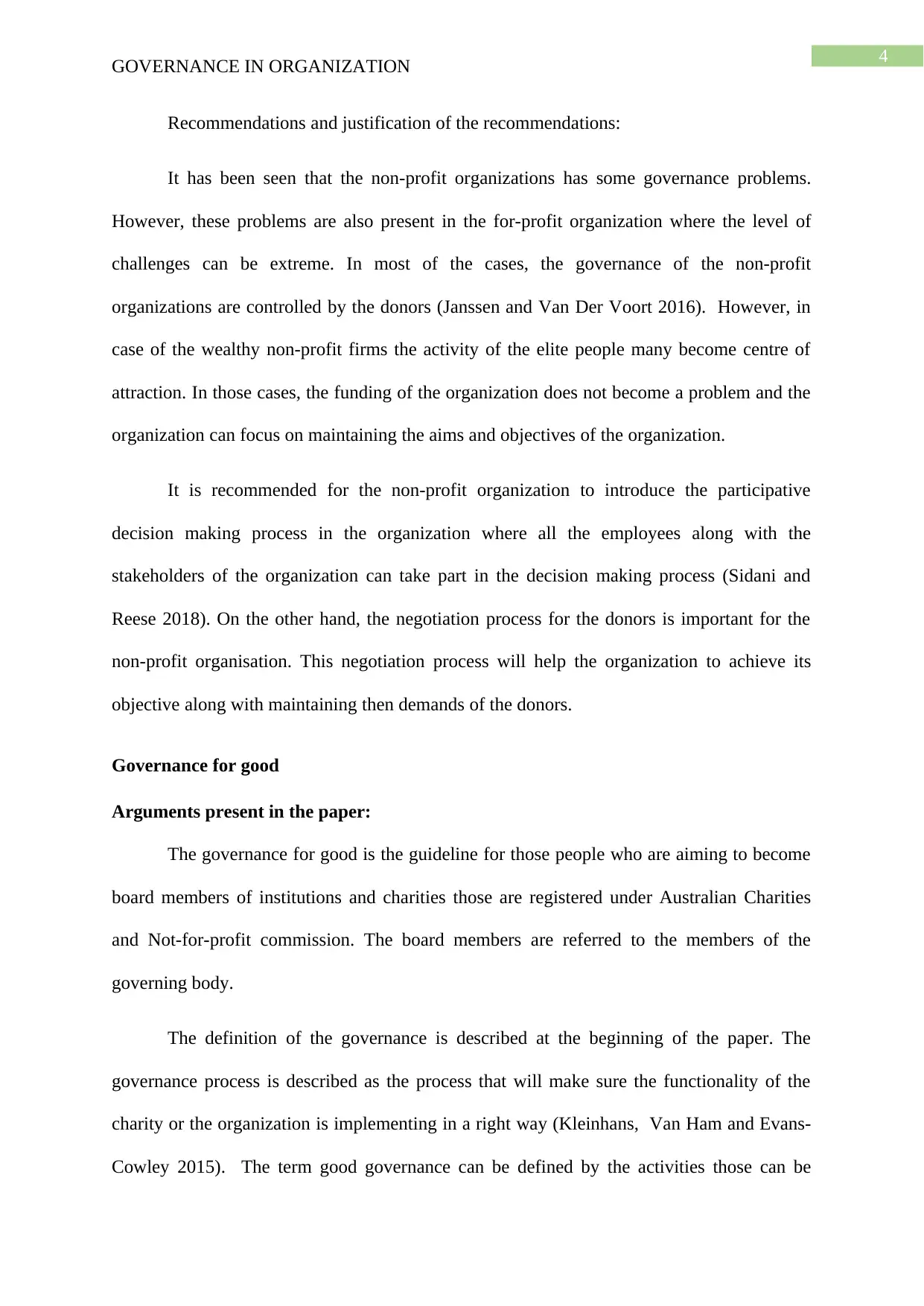
4
GOVERNANCE IN ORGANIZATION
Recommendations and justification of the recommendations:
It has been seen that the non-profit organizations has some governance problems.
However, these problems are also present in the for-profit organization where the level of
challenges can be extreme. In most of the cases, the governance of the non-profit
organizations are controlled by the donors (Janssen and Van Der Voort 2016). However, in
case of the wealthy non-profit firms the activity of the elite people many become centre of
attraction. In those cases, the funding of the organization does not become a problem and the
organization can focus on maintaining the aims and objectives of the organization.
It is recommended for the non-profit organization to introduce the participative
decision making process in the organization where all the employees along with the
stakeholders of the organization can take part in the decision making process (Sidani and
Reese 2018). On the other hand, the negotiation process for the donors is important for the
non-profit organisation. This negotiation process will help the organization to achieve its
objective along with maintaining then demands of the donors.
Governance for good
Arguments present in the paper:
The governance for good is the guideline for those people who are aiming to become
board members of institutions and charities those are registered under Australian Charities
and Not-for-profit commission. The board members are referred to the members of the
governing body.
The definition of the governance is described at the beginning of the paper. The
governance process is described as the process that will make sure the functionality of the
charity or the organization is implementing in a right way (Kleinhans, Van Ham and Evans-
Cowley 2015). The term good governance can be defined by the activities those can be
GOVERNANCE IN ORGANIZATION
Recommendations and justification of the recommendations:
It has been seen that the non-profit organizations has some governance problems.
However, these problems are also present in the for-profit organization where the level of
challenges can be extreme. In most of the cases, the governance of the non-profit
organizations are controlled by the donors (Janssen and Van Der Voort 2016). However, in
case of the wealthy non-profit firms the activity of the elite people many become centre of
attraction. In those cases, the funding of the organization does not become a problem and the
organization can focus on maintaining the aims and objectives of the organization.
It is recommended for the non-profit organization to introduce the participative
decision making process in the organization where all the employees along with the
stakeholders of the organization can take part in the decision making process (Sidani and
Reese 2018). On the other hand, the negotiation process for the donors is important for the
non-profit organisation. This negotiation process will help the organization to achieve its
objective along with maintaining then demands of the donors.
Governance for good
Arguments present in the paper:
The governance for good is the guideline for those people who are aiming to become
board members of institutions and charities those are registered under Australian Charities
and Not-for-profit commission. The board members are referred to the members of the
governing body.
The definition of the governance is described at the beginning of the paper. The
governance process is described as the process that will make sure the functionality of the
charity or the organization is implementing in a right way (Kleinhans, Van Ham and Evans-
Cowley 2015). The term good governance can be defined by the activities those can be
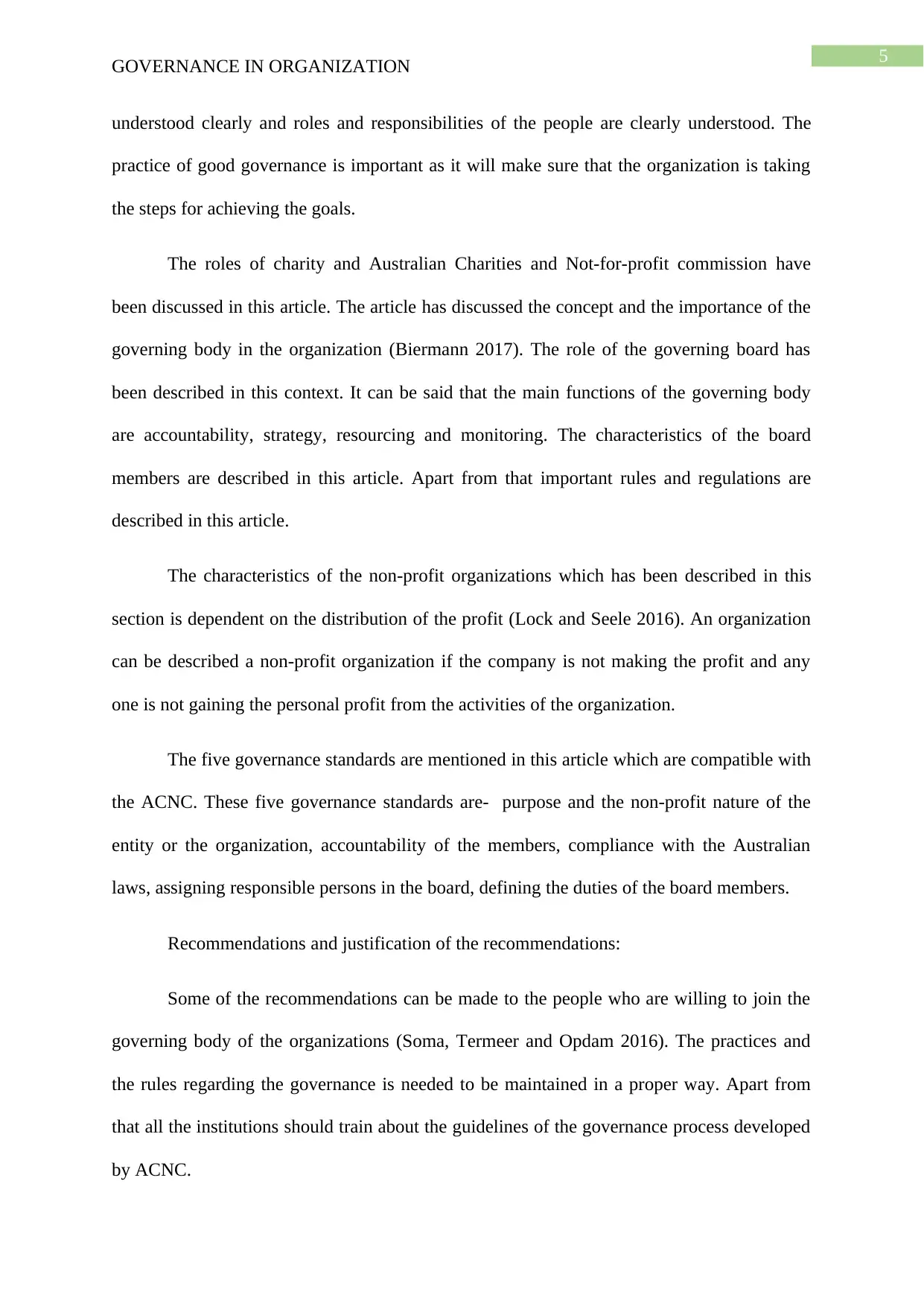
5
GOVERNANCE IN ORGANIZATION
understood clearly and roles and responsibilities of the people are clearly understood. The
practice of good governance is important as it will make sure that the organization is taking
the steps for achieving the goals.
The roles of charity and Australian Charities and Not-for-profit commission have
been discussed in this article. The article has discussed the concept and the importance of the
governing body in the organization (Biermann 2017). The role of the governing board has
been described in this context. It can be said that the main functions of the governing body
are accountability, strategy, resourcing and monitoring. The characteristics of the board
members are described in this article. Apart from that important rules and regulations are
described in this article.
The characteristics of the non-profit organizations which has been described in this
section is dependent on the distribution of the profit (Lock and Seele 2016). An organization
can be described a non-profit organization if the company is not making the profit and any
one is not gaining the personal profit from the activities of the organization.
The five governance standards are mentioned in this article which are compatible with
the ACNC. These five governance standards are- purpose and the non-profit nature of the
entity or the organization, accountability of the members, compliance with the Australian
laws, assigning responsible persons in the board, defining the duties of the board members.
Recommendations and justification of the recommendations:
Some of the recommendations can be made to the people who are willing to join the
governing body of the organizations (Soma, Termeer and Opdam 2016). The practices and
the rules regarding the governance is needed to be maintained in a proper way. Apart from
that all the institutions should train about the guidelines of the governance process developed
by ACNC.
GOVERNANCE IN ORGANIZATION
understood clearly and roles and responsibilities of the people are clearly understood. The
practice of good governance is important as it will make sure that the organization is taking
the steps for achieving the goals.
The roles of charity and Australian Charities and Not-for-profit commission have
been discussed in this article. The article has discussed the concept and the importance of the
governing body in the organization (Biermann 2017). The role of the governing board has
been described in this context. It can be said that the main functions of the governing body
are accountability, strategy, resourcing and monitoring. The characteristics of the board
members are described in this article. Apart from that important rules and regulations are
described in this article.
The characteristics of the non-profit organizations which has been described in this
section is dependent on the distribution of the profit (Lock and Seele 2016). An organization
can be described a non-profit organization if the company is not making the profit and any
one is not gaining the personal profit from the activities of the organization.
The five governance standards are mentioned in this article which are compatible with
the ACNC. These five governance standards are- purpose and the non-profit nature of the
entity or the organization, accountability of the members, compliance with the Australian
laws, assigning responsible persons in the board, defining the duties of the board members.
Recommendations and justification of the recommendations:
Some of the recommendations can be made to the people who are willing to join the
governing body of the organizations (Soma, Termeer and Opdam 2016). The practices and
the rules regarding the governance is needed to be maintained in a proper way. Apart from
that all the institutions should train about the guidelines of the governance process developed
by ACNC.
⊘ This is a preview!⊘
Do you want full access?
Subscribe today to unlock all pages.

Trusted by 1+ million students worldwide
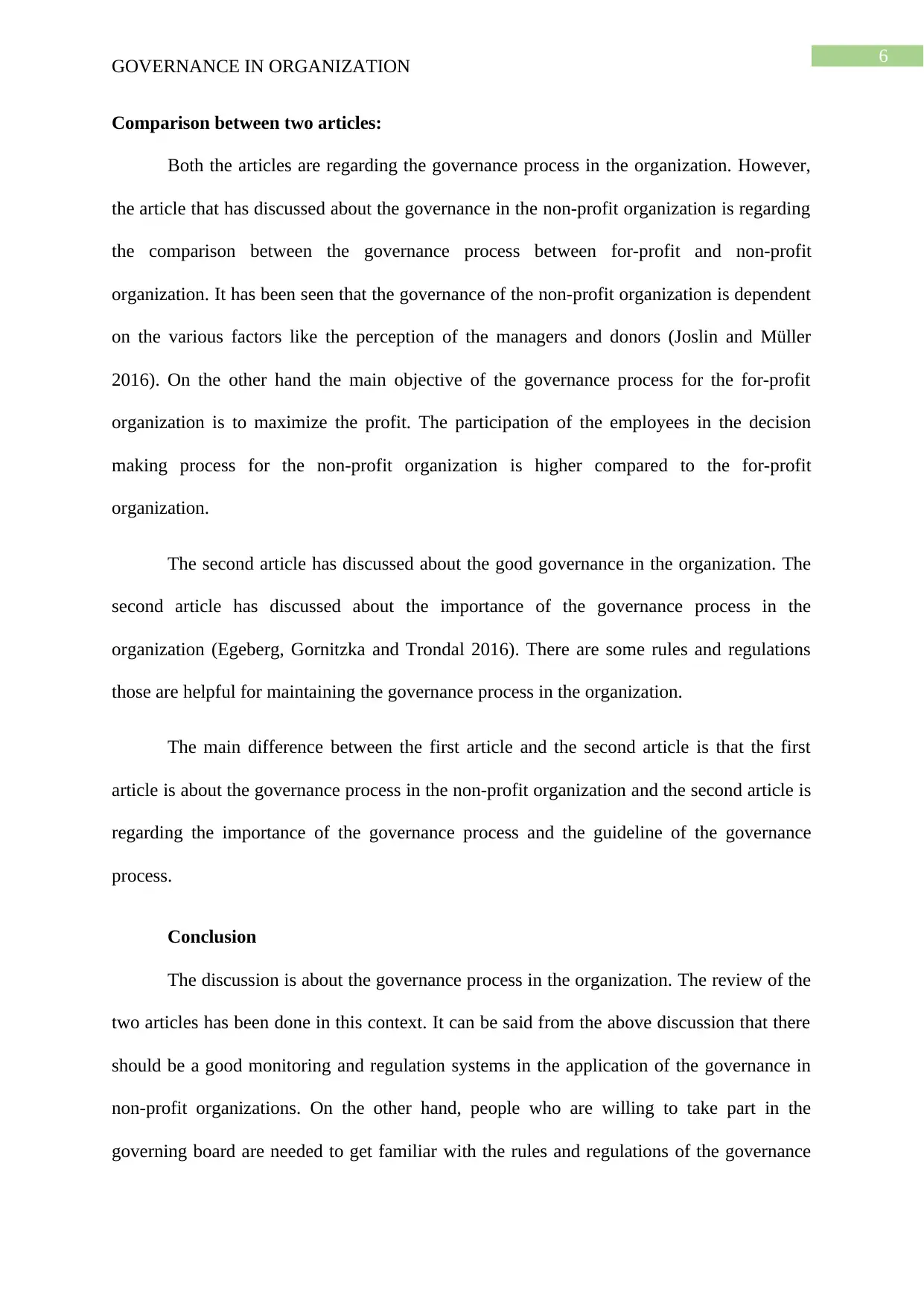
6
GOVERNANCE IN ORGANIZATION
Comparison between two articles:
Both the articles are regarding the governance process in the organization. However,
the article that has discussed about the governance in the non-profit organization is regarding
the comparison between the governance process between for-profit and non-profit
organization. It has been seen that the governance of the non-profit organization is dependent
on the various factors like the perception of the managers and donors (Joslin and Müller
2016). On the other hand the main objective of the governance process for the for-profit
organization is to maximize the profit. The participation of the employees in the decision
making process for the non-profit organization is higher compared to the for-profit
organization.
The second article has discussed about the good governance in the organization. The
second article has discussed about the importance of the governance process in the
organization (Egeberg, Gornitzka and Trondal 2016). There are some rules and regulations
those are helpful for maintaining the governance process in the organization.
The main difference between the first article and the second article is that the first
article is about the governance process in the non-profit organization and the second article is
regarding the importance of the governance process and the guideline of the governance
process.
Conclusion
The discussion is about the governance process in the organization. The review of the
two articles has been done in this context. It can be said from the above discussion that there
should be a good monitoring and regulation systems in the application of the governance in
non-profit organizations. On the other hand, people who are willing to take part in the
governing board are needed to get familiar with the rules and regulations of the governance
GOVERNANCE IN ORGANIZATION
Comparison between two articles:
Both the articles are regarding the governance process in the organization. However,
the article that has discussed about the governance in the non-profit organization is regarding
the comparison between the governance process between for-profit and non-profit
organization. It has been seen that the governance of the non-profit organization is dependent
on the various factors like the perception of the managers and donors (Joslin and Müller
2016). On the other hand the main objective of the governance process for the for-profit
organization is to maximize the profit. The participation of the employees in the decision
making process for the non-profit organization is higher compared to the for-profit
organization.
The second article has discussed about the good governance in the organization. The
second article has discussed about the importance of the governance process in the
organization (Egeberg, Gornitzka and Trondal 2016). There are some rules and regulations
those are helpful for maintaining the governance process in the organization.
The main difference between the first article and the second article is that the first
article is about the governance process in the non-profit organization and the second article is
regarding the importance of the governance process and the guideline of the governance
process.
Conclusion
The discussion is about the governance process in the organization. The review of the
two articles has been done in this context. It can be said from the above discussion that there
should be a good monitoring and regulation systems in the application of the governance in
non-profit organizations. On the other hand, people who are willing to take part in the
governing board are needed to get familiar with the rules and regulations of the governance
Paraphrase This Document
Need a fresh take? Get an instant paraphrase of this document with our AI Paraphraser

7
GOVERNANCE IN ORGANIZATION
of the organizations. These rules and regulations are abided and approved by ACNC. From
the comparative discussion of these two articles it can be said that governance process is
important for both for-profit and non-profit organizations. The people of the governing body
should abide by the rules and regulations during the practice of the governance process.
GOVERNANCE IN ORGANIZATION
of the organizations. These rules and regulations are abided and approved by ACNC. From
the comparative discussion of these two articles it can be said that governance process is
important for both for-profit and non-profit organizations. The people of the governing body
should abide by the rules and regulations during the practice of the governance process.
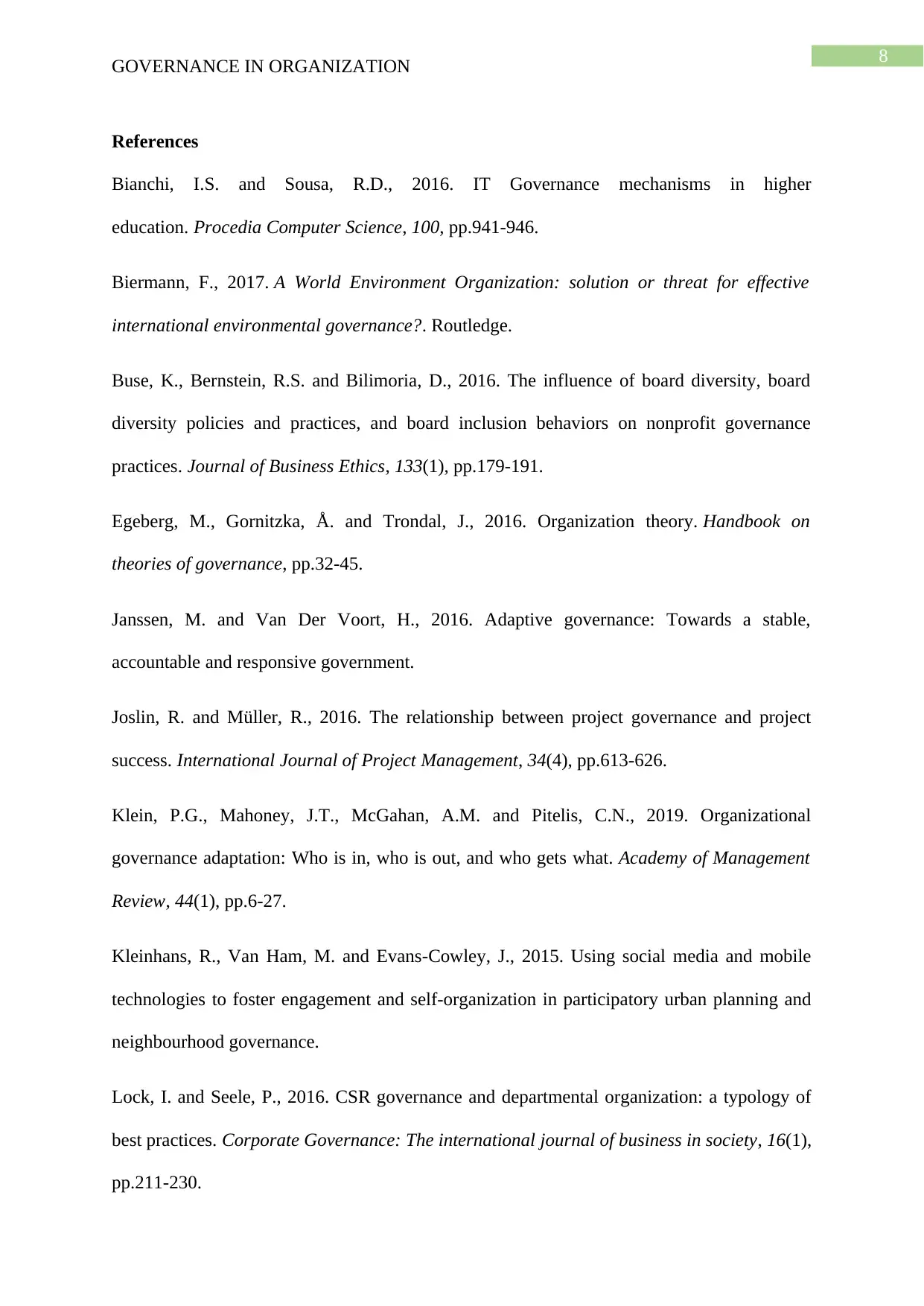
8
GOVERNANCE IN ORGANIZATION
References
Bianchi, I.S. and Sousa, R.D., 2016. IT Governance mechanisms in higher
education. Procedia Computer Science, 100, pp.941-946.
Biermann, F., 2017. A World Environment Organization: solution or threat for effective
international environmental governance?. Routledge.
Buse, K., Bernstein, R.S. and Bilimoria, D., 2016. The influence of board diversity, board
diversity policies and practices, and board inclusion behaviors on nonprofit governance
practices. Journal of Business Ethics, 133(1), pp.179-191.
Egeberg, M., Gornitzka, Å. and Trondal, J., 2016. Organization theory. Handbook on
theories of governance, pp.32-45.
Janssen, M. and Van Der Voort, H., 2016. Adaptive governance: Towards a stable,
accountable and responsive government.
Joslin, R. and Müller, R., 2016. The relationship between project governance and project
success. International Journal of Project Management, 34(4), pp.613-626.
Klein, P.G., Mahoney, J.T., McGahan, A.M. and Pitelis, C.N., 2019. Organizational
governance adaptation: Who is in, who is out, and who gets what. Academy of Management
Review, 44(1), pp.6-27.
Kleinhans, R., Van Ham, M. and Evans-Cowley, J., 2015. Using social media and mobile
technologies to foster engagement and self-organization in participatory urban planning and
neighbourhood governance.
Lock, I. and Seele, P., 2016. CSR governance and departmental organization: a typology of
best practices. Corporate Governance: The international journal of business in society, 16(1),
pp.211-230.
GOVERNANCE IN ORGANIZATION
References
Bianchi, I.S. and Sousa, R.D., 2016. IT Governance mechanisms in higher
education. Procedia Computer Science, 100, pp.941-946.
Biermann, F., 2017. A World Environment Organization: solution or threat for effective
international environmental governance?. Routledge.
Buse, K., Bernstein, R.S. and Bilimoria, D., 2016. The influence of board diversity, board
diversity policies and practices, and board inclusion behaviors on nonprofit governance
practices. Journal of Business Ethics, 133(1), pp.179-191.
Egeberg, M., Gornitzka, Å. and Trondal, J., 2016. Organization theory. Handbook on
theories of governance, pp.32-45.
Janssen, M. and Van Der Voort, H., 2016. Adaptive governance: Towards a stable,
accountable and responsive government.
Joslin, R. and Müller, R., 2016. The relationship between project governance and project
success. International Journal of Project Management, 34(4), pp.613-626.
Klein, P.G., Mahoney, J.T., McGahan, A.M. and Pitelis, C.N., 2019. Organizational
governance adaptation: Who is in, who is out, and who gets what. Academy of Management
Review, 44(1), pp.6-27.
Kleinhans, R., Van Ham, M. and Evans-Cowley, J., 2015. Using social media and mobile
technologies to foster engagement and self-organization in participatory urban planning and
neighbourhood governance.
Lock, I. and Seele, P., 2016. CSR governance and departmental organization: a typology of
best practices. Corporate Governance: The international journal of business in society, 16(1),
pp.211-230.
⊘ This is a preview!⊘
Do you want full access?
Subscribe today to unlock all pages.

Trusted by 1+ million students worldwide
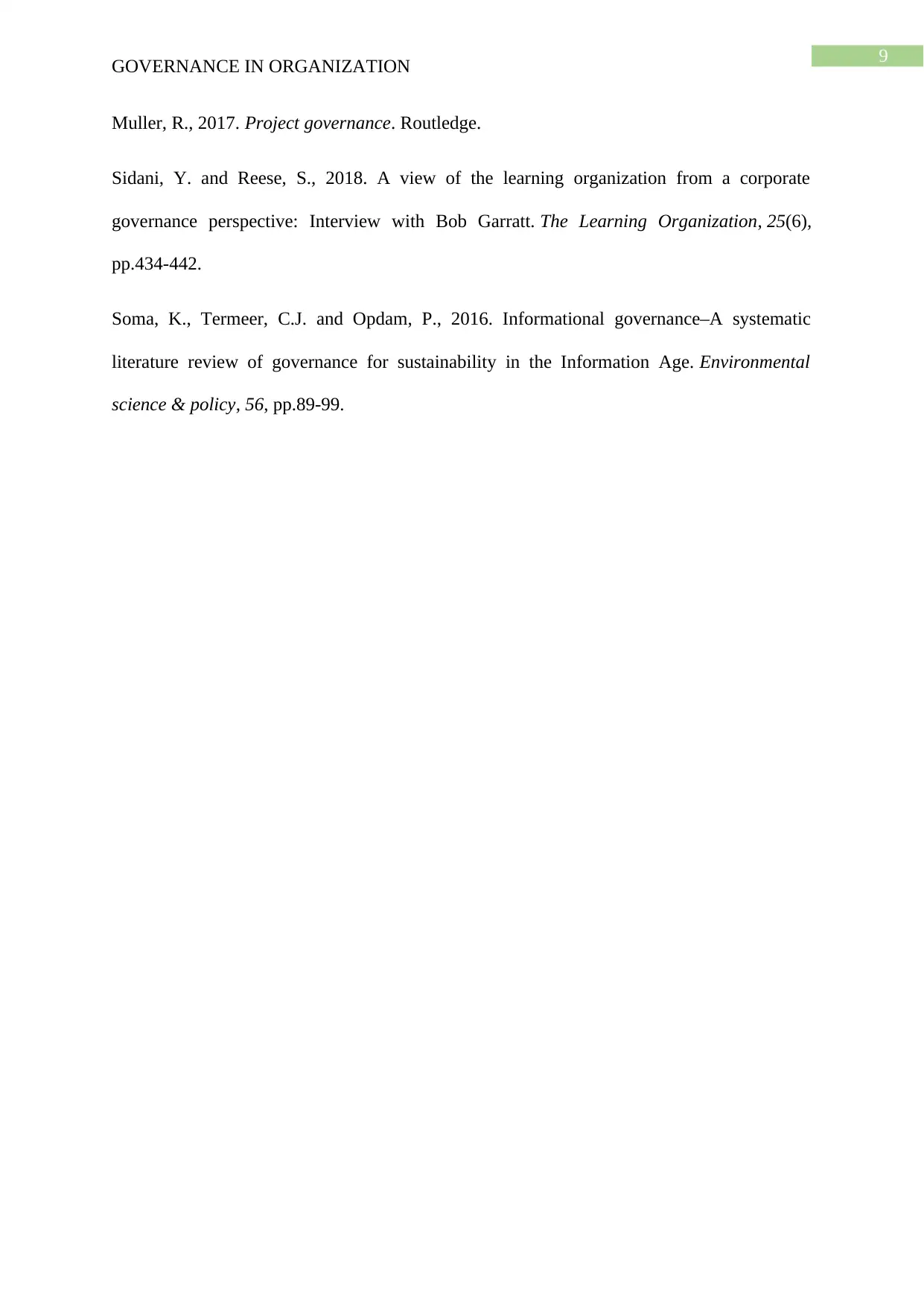
9
GOVERNANCE IN ORGANIZATION
Muller, R., 2017. Project governance. Routledge.
Sidani, Y. and Reese, S., 2018. A view of the learning organization from a corporate
governance perspective: Interview with Bob Garratt. The Learning Organization, 25(6),
pp.434-442.
Soma, K., Termeer, C.J. and Opdam, P., 2016. Informational governance–A systematic
literature review of governance for sustainability in the Information Age. Environmental
science & policy, 56, pp.89-99.
GOVERNANCE IN ORGANIZATION
Muller, R., 2017. Project governance. Routledge.
Sidani, Y. and Reese, S., 2018. A view of the learning organization from a corporate
governance perspective: Interview with Bob Garratt. The Learning Organization, 25(6),
pp.434-442.
Soma, K., Termeer, C.J. and Opdam, P., 2016. Informational governance–A systematic
literature review of governance for sustainability in the Information Age. Environmental
science & policy, 56, pp.89-99.
1 out of 10
Related Documents
Your All-in-One AI-Powered Toolkit for Academic Success.
+13062052269
info@desklib.com
Available 24*7 on WhatsApp / Email
![[object Object]](/_next/static/media/star-bottom.7253800d.svg)
Unlock your academic potential
Copyright © 2020–2025 A2Z Services. All Rights Reserved. Developed and managed by ZUCOL.





